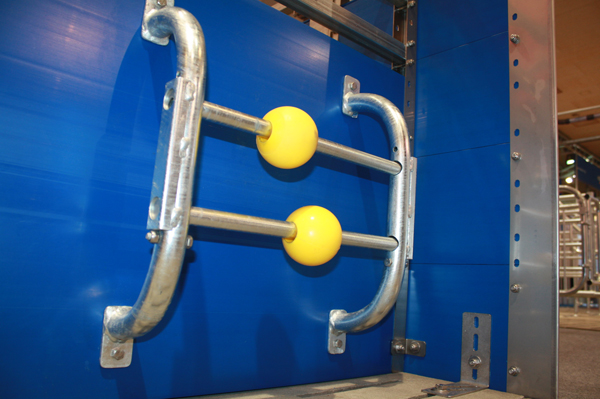Toys for pigs sneaking in to shows

Any trained eye could see them at EuroTier in Germany – and at the NutriFair in Denmark, they also popped up at various booths: Colourful, wooden, rubber or iron: Rooting material for pigs – to keep them happy.
The attention for toys is the result of just another line in recent European Directives, albeit one that escaped much of the attention as the 2013 deadline for gestation crates/ sow stalls was what many focused on.
However, it is clearly there. The Council Directive 2001/88/EC aims to ‘allow the sows and gilts to have permanent access to materials for rooting’. In addition, Directive 2001/93/EC states that pigs should have ‘permanent access to materials for rooting and playing.’
So what have companies come up with to keep our four legged friends entertained? What follows is a little walk through pig toy land – possibly with a lot more to come.
For sows, long wooden sticks can be provided, with a device to keep them horizontal. It was displayed in many booths at NutriFair as part of a farrowing house. This particular example was photographed at Egebjerg International.
Offering straw to pigs and sows is another way to keep them entertained, although straw may dilute the manure content underneath the slats. Hanging troughs are a possibility to provide the straw. This example is from AP Company.
AP Company also introduced a novel, patent-pending toy for pigs at NutriFair.
At EuroTier, German housing solutions manufacturer Weda introduced a range of different rooting materials, most of them featuring a robust yellow ball. According to Ralf Meyer, head of development, the company received many interest for its innovations.
There were extra adjustments with a rack to be fixed on a sow wall – or three for playing on the floor.
Most interest, Meyer said, was for an easy-to-add ball on existing pipes. He told Pig Progress, “The people are very interested in that toy because it is made in two parts. You can screw it very simply on the pipes in front of the sow.”
It just goes to show that in pigs, more is needed than cunning techniques or revolutionary concepts to make an innovation being a commercial success. It’s called simplicity.







